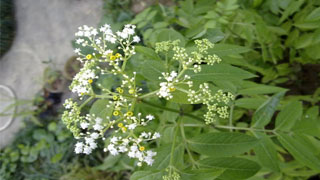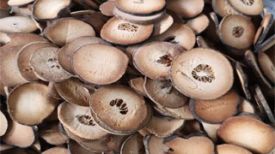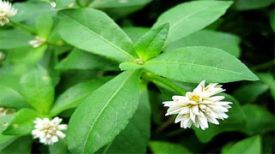
1. Aliases
Zouma Feng, Capsule Huo Gen, Lu Ying Gen, elderberry, Pai Feng Teng, Qi Ye Gen, Palm Luo Gen.2. Plant morphology
Shrubsy herbaceous plants. The main root is vertical and there are not many branching roots. Stems with edges, smooth and hairless. Leaves opposite, singly pinnate compound, leaflets 5-9, long elliptical lanceolate, apex gradually pointed, base slightly rounded or broadly wedge-shaped, edges with dense and sharp serrations, smooth and hairless on both sides, or short pubescence on leaf veins; Without stipules, the petiole is short or nearly sessile. The compound umbel shaped inflorescence is terminal and has short pubescence; Small bracts, ovate and lanceolate; Calyx 5-lobed, the lower part becomes more bell shaped; Corolla white, 5-lobed, lobes ovate; 5 stamens, alternate with corolla lobes, short filaments, anther chambers opening outward; Ovary ovoid, stigma head shaped; There are yellow cup-shaped glands mixed between the flowers. Berry spherical, red. The flowering period is in August, and the fruiting period is in October.
3. Origin distribution
Born on the roadside villages, wastelands, or sunny valleys in the mid high altitude mountains. Distributed in Guangdong, Guangxi, Jiangxi and other places.
4. Harvesting and processing
Harvest year-round, dig the roots, remove the fibrous roots and sediment, wash and dry in the sun.
5. Characteristics of medicinal herbs
The walking horse arrow is elongated, slightly flattened, with a curved base and branches. It is 15-50 centimeters long and has a diameter of 0.3-0.8 centimeters. The surface is grayish yellow, with protruding and darker horizontal long skin pores, slightly twisted fine vertical wrinkles and fine hairs. Hard and tough, difficult to break, with torn separation between the skin and wood on the cross-section. The skin is gray yellow in color, while the wood is fibrous and yellow white in color. Slight breath, light taste.
6. Nature, taste, and meridian tropism
Warm in nature, sweet and sour in taste.
7. Effect and function
Dispelling wind and dampness, promoting blood circulation and dispersing blood stasis. Belonging to the subcategory of dispelling wind and dampness, it is a strong muscle and bone medicine for dispelling wind and dampness.
8. Clinical applications
Dosage 6-12 grams, fresh 30-60 grams, decoct and take; Or apply externally by tamping; Or boil and wash with water. Used to treat rheumatic pain, nephritis edema, athlete's foot edema, dysentery, jaundice, chronic bronchitis, rubella and itching, erysipelas, sores and swelling, falls and injuries, and fractures.
9. Pharmacological research
Animal experiments have shown that the Walking Horse Arrow has the effects of accelerating fracture healing and reducing swelling. Its injection has good clinical efficacy in treating acute dysentery, acute suppurative tonsillitis, and pneumonia.
10. Chemical composition
Zouma Arrow contains flavonoids, phenolic compounds, tannins, sugars, and chlorogenic acids.
11. Taboos for use
It is not yet clear.
12. Compatibility prescription
1. Treatment for edema, inability to sit or lie down, and swelling of the head, face, and body: Scrape the skin from the roots of the capsule, mash the juice together, mix it with wine, take a warm and hollow coat, and spit it out slightly. ("Mei Shi Ji Yan Fang")
2. Treatment of wind on the head: Take one liter of pounded capsule and patchouli root, and two liters of wine for soaking. Sweating stops. (Xia Jin Fang)
3. Treatment of nephritis and systemic edema: 60g of Lu Yinggen, 30g of Jin Sicao and Yanzhou Selaginella each. Boiled in water. (Fujian Pharmacopoeia)
4. Treating symptoms of violence: A small bundle of walking arrows. Wash and drain the water, cut it finely, soak it in mellow wine, take the submerged roots for two nights, take a five part mixture, and bring it to one liter. Three days a day. If you want to get it quickly, you can mix it with hot ash to make the medicine taste better, and take it. (From "Waitai" to "Ancient and Modern Records and Verification Methods")
5. Treatment of bruises or cramps: (Herba Artemisiae Capsulae) cut fresh roots, apply them to the affected area with scallion and mashed lees, and change them once a day. (Jiangxi Folk Herbs)
The content of the article is for clinical reference only. Non professionals in traditional Chinese medicine are not allowed to try medication.


